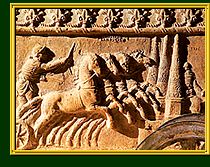|
"Was there any historical
precedent for a pony-sized horse in Iran and, if so, how well documented was it?"
-- Louise Firouz, after initial discovery of 3 Caspians.
 This question initiated a study in the spring of 1965 to determine the range, nature and historical precedent for a horse of this size in Iran. The results have supported Louise's theory that this little horse was the 5,000 year old lost Royal Horse of Persia.
This question initiated a study in the spring of 1965 to determine the range, nature and historical precedent for a horse of this size in Iran. The results have supported Louise's theory that this little horse was the 5,000 year old lost Royal Horse of Persia.
Louise Firouz was already familiar with ancient artifacts depicting a small horse of the royals that had the same appearance as the Caspians she had discovered. This knowledge would become the spring board for further investigation.
Archaeologists, Zoologists, equine historians, and genetic researchers contributed a wealth of information to this investigation. Mrs. Mary Littauer, an authority on the history of the horse, assisted in the research of osteological remains. David Stronach, specializing in Persian Studies and zoologist, Sandor Bokoni added their expertise.
From this research, among many other extensive findings, it was determined that the horses depicted on the walls of the ancient palace of Persepolis, did actually exist and were not mere "renderings" of an imaginery small horse.
Mr. Elwyn Hartley Edwards, an equine historian and author of The Encyclopedia of the Horse, relates the Caspian to the fourth horse type from which all modern day breeds derive.
Dr. Gus Cothran, who has conducted extensive DNA research at the University of Kentucky, concurs that the Caspian Horse is in an ancestral position to most breeds.
Among the other fascinating findings of the extensive research, are the five basic skeletal differences found between the Caspian and all other breeds.
- The Caspian skull shows a pronounced elevation of the interparietal bones and the Caspian possesses no parietal crest.
- The scapula is wider than in other breeds.
- The metacarpal and metatarsal bones are much longer and slimmer in comparison with the height of the horse.
- The spinous processes of the first six thoracic vertebrae show a pronounced elongation.
- The hoof is narrow and oval-shaped, rarely needing to be shod.
The Caspian has maintained its small, elegant stature of approximately 10-12 hands for almost 5,000 years. Research has demonstrated that the Caspian has kept its small stature under all types of demographic and environmental conditions, further evidence of its purity, distinction and unique lineage over so many centuries.
|

